Building Science in Relation to Moisture and Microbial Growth
Micro-organisms can be found in the air inside a building, on a surface inside a building (on the floor, ceiling, walls and furniture), and inside the HVAC system of a building. Many of these microorganisms come indoors from outside. They come from decaying organic matter or moist earth.
Micro-organisms can enter a building by floating with outdoor air that enters the building, or they can travel on people and animals who bring them inside.
Micro-organisms might be present on the building materials as the structure is being constructed. Oftentimes, inspectors will find building materials lying on the ground at a new construction site. These materials absorb moisture and dirt and may support mold growth inside the building, after construction has been completed.
Mold growth is not desirable in a building and must be prevented. There are three reasons to prevent fungal growth inside a building: the potential negative health effects of exposure to fungi and their byproducts; the effects of mold contamination on the structural integrity of the building; and the negative aesthetic effects fungi can produce, both visually and on the human olfactory system.
Moisture, Temperature, Food and Time
There are four factors involved in mold growth. The following conditions are necessary for mold growth to thrive on surfaces:
- a temperature range between 40° and 100° F;
- the presence of mold spores;
- a nutrient base (most surfaces contain nutrients); and
- moisture.
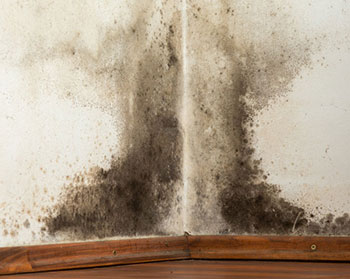 Human comfort constraints limit the practical ability to control the temperature in the growth of mold. The air temperature inside a building that is suitable for occupants is also beneficial for mold growth. Most buildings are kept between 65° and 75° F, and this temperature range is also suitable for mold to grow, although some fungi can thrive in temperatures as cold as 15° F and as hot as 122° F. Spores are almost always present in outdoor and indoor air. Almost all construction materials and furnishings can provide nutrients to support mold growth, and dirt on surfaces provides additional nutrients. It is virtually impossible to eliminate all nutrients. A building is filled with an abundant supply of food for mold growth. Fungi have been shown to colonize on drywall, wood paneling, wallpaper, ceiling tiles, carpeting and pads, furniture, insulated ductwork, and other building components. The fungi break down the materials for food or use the dust that has collected on a surface as a nutrient source.
Human comfort constraints limit the practical ability to control the temperature in the growth of mold. The air temperature inside a building that is suitable for occupants is also beneficial for mold growth. Most buildings are kept between 65° and 75° F, and this temperature range is also suitable for mold to grow, although some fungi can thrive in temperatures as cold as 15° F and as hot as 122° F. Spores are almost always present in outdoor and indoor air. Almost all construction materials and furnishings can provide nutrients to support mold growth, and dirt on surfaces provides additional nutrients. It is virtually impossible to eliminate all nutrients. A building is filled with an abundant supply of food for mold growth. Fungi have been shown to colonize on drywall, wood paneling, wallpaper, ceiling tiles, carpeting and pads, furniture, insulated ductwork, and other building components. The fungi break down the materials for food or use the dust that has collected on a surface as a nutrient source.
Temperature, food, and time cannot be adequately manipulated to control microbial growth, but moisture can. Moisture is the controlling factor. Therefore, moisture control is the primary strategy to focus on in order to limit and prevent mold growth. Once moisture intrusion into a building takes place, mold can start growing in very little time. Fungi have been shown to be capable of germination, growth, and sporulation in as little as 24 hours after water intrusion or damage occurs.
Building Science
To understand how to find mold and prevent its growth in a building, inspectors must study and understand building science. Building science, in relation to mold, is the study of the building’s dynamics as affected by moisture intrusion. Buildings are dynamic environments influenced by geographic location, season, weather conditions, the HVAC’s system design and operation, moisture intrusion, pest colonization, and human activities. Building dynamics continually change and affect the conditions for mold growth.
Moisture Content
Moisture content (MC) is often expressed as a percentage (100 x (wet mass – dry mass)) ÷ (dry mass), or in terms of the amount of water in a certain volume (lbs./ft. cubed).
Mold requires moisture to survive, so protecting lumber and wood structures from moisture will help prevent mold growth. Mold growth can be limited if the MC of wood can be kept below 20%. An MC below 17% means that virtually no microbial growth will occur on even the most susceptible materials. Southern pine dimensional lumber is typically kiln-dried to a maximum 19% MC or less. The moisture content is indicated on the grade stamp. Moisture content is related directly to particular substrates or materials. Microbial growth is limited when the MC of gypsum board is below 0.6%, when brick is below 0.8%, when wallpaper is below 10.5%, and when concrete is below 5%. One study showed that a moisture content greater than 5% permitted the growth of Penicillium glabrum and Aspergillus versicolor on ceiling tiles in a laboratory.
Mold growth does not require the presence of standing water; it can occur when high relative humidity or the hygroscopic properties (the tendency to absorb and retain moisture) of building surfaces allow sufficient moisture to accumulate. Relative humidity and the factors that govern it are often misunderstood. This section is intended to give building inspectors an understanding of the factors that govern relative humidity, and to describe common moisture problems and their solutions.
Relative Humidity
Understanding relative humidity in a building is essential to controlling mold growth. Relative humidity (RH) is a ratio (expressed as a percentage) of the amount of moisture in the air to the maximum amount of moisture the air can hold. Warm air can hold more moisture than cool air. RH is a factor in determining how much moisture is present in a room, but it is the available moisture in a substrate (not the RH of the room’s air) that determines if mold can grow or not.
Many sources recommend maintaining RH in living spaces below 60% to limit microbial growth. By keeping RH below 60%, one may assume that the moisture content in building materials would be low. However, this assumption may be false because mold grows on surfaces and in building materials, not in the air. Therefore, it is the RH in the air adjacent to the surface, not the ambient RH, that must be lowered in order to control mold growth. Measuring a room with an RH at or below 60% may mean that the building materials are fairly dry, but it does not eliminate the possibility of mold growth because local cold spots and water intrusion may allow the RH of the air
adjacent to the surface to exceed 70%. Moisture meters are essential for inspectors; they enable inspectors to identify damp areas that would otherwise not be evident. Infrared cameras are praised for their ability to detect moisture that is not readily visible.
Water enters buildings both as a liquid and as a gas (water vapor). Water, in its liquid form, is introduced intentionally in bathrooms, kitchens and laundries, but accidentally by way of leaks and spills. Some of that water evaporates and joins the water vapor that is exhaled by building occupants as they breathe, or that which is introduced by humidifiers. Water vapor also moves in and out of the building as part of the air that is mechanically introduced or that infiltrates and exfiltrates through openings in the building’s shell. A lesser amount of water vapor diffuses into and out of the building through the building materials themselves.
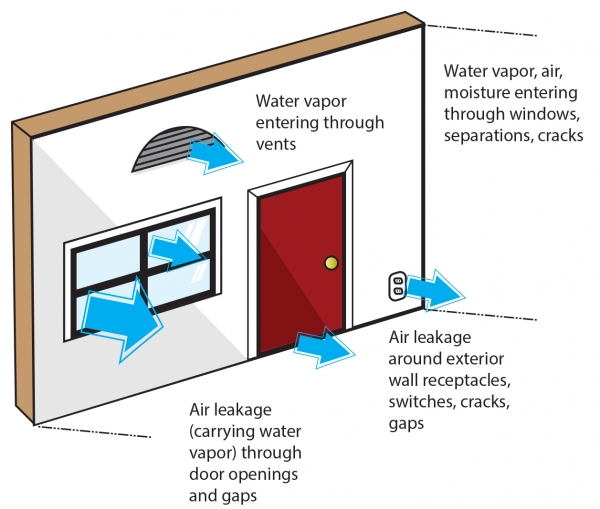
This sketch illustrates the usual locations of moisture entry, and how all those entry paths can add to the moisture gain of the building.
The ability of air to hold water vapor decreases as the air temperature is lowered. If a unit of air contains half of the water vapor it can hold, it is said to be at 50% relative humidity (RH). As the air cools, the relative humidity increases. RH rises as the air cools because cooler air has a lower moisture-holding capacity, increasing the risk of condensation in walls. If the air contains all of the water vapor it can hold, it is at 100% RH, and the water vapor condenses, changing from a gas to a liquid. It is possible to reach 100% RH without changing the amount of water vapor in the air (its vapor pressure or absolute humidity); all that is required is for the air temperature to drop to the dew point.
Relative humidity and temperature often vary within a room, while the absolute humidity in the room’s air can usually be assumed to be uniform. Therefore, if one side of the room is warm and the other side is cool, the cool side of the room has a higher RH than the warm side.
The highest RH in a room is always next to the coldest surface. This is referred as the “first condensing surface,” as it will be the location where condensation first occurs if the relative humidity at the surface reaches 100%. It is important to understand this when trying to understand why mold is growing on one patch of wall or only along the wall-ceiling joint. It is likely that the surface of the wall is cooler than the room’s ambient air because there is a void in the insulation, or because wind is blowing through cracks in the exterior of the building.
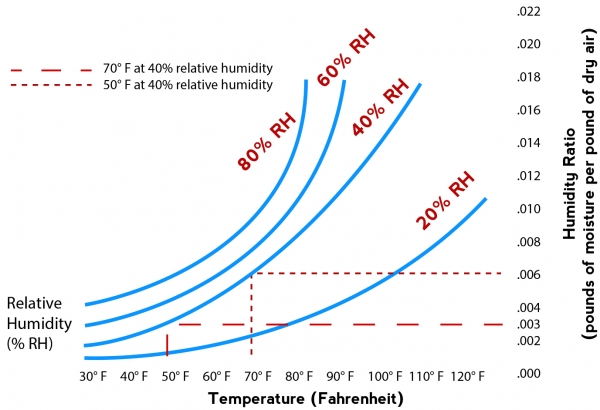 The chart above showing the relative humidity reading taken in a room will only give an accurate indication of the actual amount of moisture present if a temperature reading is taken at the same time. The chart shows that air at 70° F and 40% RH contains approximately 0.006 pounds of moisture per pound of dry air (as indicated by the bold line), while air that is at 50° F and 40% RH contains approximately 0.003 pounds of moisture per pound of dry air (as indicated by the dashed line). Although both are at 40% RH, the 70° F air contains roughly twice as much moisture as the 50° F air.
The chart above showing the relative humidity reading taken in a room will only give an accurate indication of the actual amount of moisture present if a temperature reading is taken at the same time. The chart shows that air at 70° F and 40% RH contains approximately 0.006 pounds of moisture per pound of dry air (as indicated by the bold line), while air that is at 50° F and 40% RH contains approximately 0.003 pounds of moisture per pound of dry air (as indicated by the dashed line). Although both are at 40% RH, the 70° F air contains roughly twice as much moisture as the 50° F air.
Condensation in Cold Climates
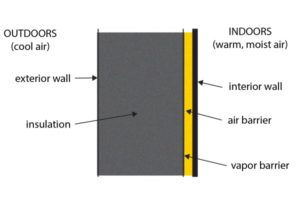
Condensation in cold climates
The basic idea in controlling condensation due to vapor migration is to prevent warm, moisture-laden air from contacting cool surfaces. In cold climates, condensation can occur within an exterior wall of a building when warm, moist indoor air flows outward. This warm, moist air cools as it nears the outer boundary of the exterior wall.
RH rises as the air cools because cooler air has a lower moisture-holding capacity, which increases the potential for condensation forming in the walls.
To control condensation in a building’s exterior walls in cold climates:
- Install insulation to prevent large temperature differences between the air and surfaces.
- Install air or vapor barriers on the warm side of the building envelope.
- Use ventilation to reduce indoor moisture levels below levels that allow condensation to occur.
Condensation in Hot and Humid Climates

Condensation warm climates
To control condensation in a building’s exterior walls in hot, humid climates:
- Install insulation to prevent large temperature differences between the air and surfaces.
- Install air or vapor barriers on the exterior-side of the building envelope.
- Avoid impermeable vinyl or other wall coverings, and use permeable paints and wall coverings on the interior surfaces of the exterior walls.
- The HVAC system should be producing net-positive pressures on the inside of the building, with respect to the outdoors, to avoid entry of outdoor air inward.
- Try to avoid cooling interior spaces below the average monthly outdoor dew-point temperature for the climate where the building is located. In some areas, this may not be possible.
Many buildings incorporate vapor barriers in the design of their walls and floors. Vapor barriers must be located and installed properly or the building may develop moisture problems. A vapor barrier is a layer of material that slows or prevents the absorption or release of moisture from or into a wall or floor. Vapor barriers can prevent damp or wet building materials from drying quickly enough, which may allow mold growth.
Humidifiers
Moisture from humidifiers may support microbial growth on wet surfaces where moisture can condense during cold weather. Humidifiers that discharge small droplets of water from a reservoir are prone to supporting mold growth. Moisture accumulation inside dirty ductwork creates a suitable environment for mold growth. The reservoir of the humidifier is usually contaminated to some degree. Humidifiers should be considered potential sources for mold growth.
Windows
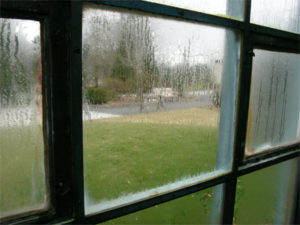
Condensation on window
In winter, windows are typically the coldest surfaces in a room. The interior surface of a window is often the first condensing surface in a room. Condensation on window surfaces has historically been controlled by using storm windows or insulated glass to raise interior surface temperatures. The advent of high-performance glazing systems has led to a greater incidence of moisture problems in heating climate-controlled building enclosures because the buildings can now be operated at higher interior vapor pressures (or moisture levels) without visible surface condensation on windows. In older building enclosures with less advanced glazing systems, visible condensation on the windows can alert the occupants to the need for ventilation to flush out interior moisture (such as by opening the windows).
RH and Temperature
Mold is often found on the exterior wall surfaces of corner rooms in cold climates. An exposed corner room is likely to be significantly colder than adjoining rooms, so it has a higher relative humidity (RH) than other rooms at the same water-vapor pressure. If mold growth is found in a corner room, then relative humidity levels next to the room’s surfaces are above 70%. However, is the RH above 70% at the surfaces because the room is too cold, or because there is too much moisture present (or high water-vapor pressure)?
The amount of moisture in the room can be estimated by measuring both temperature and RH at the same location at the same time. Suppose there are two cases: In the first case, assume that the RH is 30% and the temperature is 70° F in the middle of the room. The low RH at that temperature indicates that the water-vapor pressure (or absolute humidity) is low. The high surface-RH is probably due to room surfaces that are “too cold.” Temperature is the dominant factor, and control strategies should involve increasing the temperature at cold room surfaces.
In the second case, assume that the RH is 50% and the temperature is 70° F in the middle of the room. The higher RH at that temperature indicates that the water-vapor pressure is high, and there is a relatively large amount of moisture in the air. The high surface-RH is probably due to air that is “too damp.” Humidity is the dominant factor, and control strategies should involve decreasing the moisture content of the indoor air.
Conclusion
Owners and tenants should prevent mold growth inside buildings. Fungal growth inside buildings jeopardizes the health of building occupants and the building’s structural integrity. It also negatively affects a building’s aesthetics.
Building science plays a significant role in preventing moisture and microbial growth. The main building science factors include moisture content, relative humidity, condensation, humidifiers, windows, relative humidity, and temperature. These factors change by geographic location, season, weather conditions, the HVAC system design and operation, moisture intrusion, pest colonization, and human activities.

